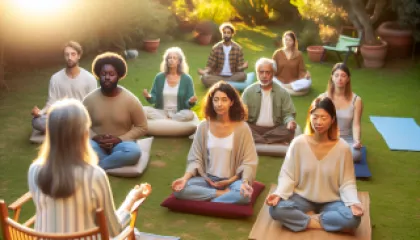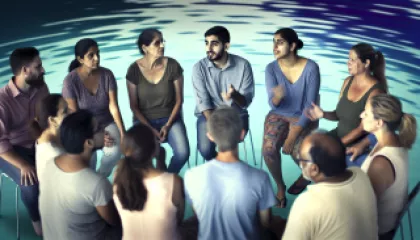Effective Relaxation Techniques for Caregivers
Caring for a loved one can be incredibly rewarding, but it also comes with its fair share of challenges. Caregivers often find themselves under immense stress, constantly juggling multiple responsibilities and putting their own needs on the back burner. This can take a toll on their mental and physical well-being.
Recognizing the importance of self-care is crucial for caregivers. Taking time to relax and recharge not only benefits their own mental health but also allows them to provide better care for their loved ones. In this tutorial, we will explore effective relaxation techniques specifically tailored for caregivers.
The Impact of Caregiver Stress
Caregiving can be an emotionally demanding role, leading to chronic stress if left unaddressed. The constant pressure, lack of personal time, and the emotional strain of witnessing a loved one's suffering can all contribute to caregiver burnout.
When caregivers neglect their own well-being, they are more susceptible to a range of physical and mental health issues, including:
- Depression: Feelings of sadness, hopelessness, and loss of interest in activities.
- Anxiety: Excessive worry, restlessness, and difficulty concentrating.
- Insomnia: Trouble falling asleep or staying asleep.
- Chronic fatigue: Persistent tiredness and lack of energy.
- Physical ailments: Headaches, digestive problems, and weakened immune system.
It is crucial for caregivers to prioritize their own well-being and incorporate relaxation techniques into their daily routine. Let's explore some effective strategies for managing stress and promoting mental health.
1. Deep Breathing Exercises
Deep breathing exercises are a simple yet powerful way to promote relaxation and reduce stress. They help activate the body's natural relaxation response, calming the mind and relieving tension.
To practice deep breathing:
- Find a quiet, comfortable space: Sit or lie down in a position that feels relaxing.
- Close your eyes: This helps minimize distractions and allows you to focus inward.
- Inhale deeply through your nose: Take a slow, deep breath in, filling your lungs as much as possible.
- Exhale slowly through your mouth: Release the breath gradually, feeling the tension leave your body.
- Repeat: Continue the deep breathing for several minutes, focusing on the sensation of your breath.
Practicing deep breathing exercises for just a few minutes each day can have a profound impact on stress levels and overall well-being.
2. Progressive Muscle Relaxation
Progressive muscle relaxation is a technique that involves tensing and relaxing different muscle groups to promote deep relaxation. It helps release physical tension and can have a calming effect on the mind.
To practice progressive muscle relaxation:
- Find a comfortable position: Sit or lie down in a quiet space.
- Start with your toes: Tense the muscles in your toes and hold for a few seconds, then release and relax.
- Work your way up: Gradually move up your body, tensing and releasing each muscle group, including your legs, abdomen, chest, arms, and face.
- Focus on the contrast: Pay attention to the difference between tension and relaxation in each muscle group.
- Take deep breaths: Inhale deeply during the tension phase and exhale fully during the relaxation phase.
Progressive muscle relaxation can be practiced whenever you feel overwhelmed or tense. Regular practice can help you recognize and release tension more effectively.
3. Guided Imagery
Guided imagery is a relaxation technique that involves using your imagination to create calming mental images. It can transport you to a peaceful place and help reduce stress and anxiety.
To practice guided imagery:
- Find a quiet, comfortable space: Sit or lie down in a place where you won't be disturbed.
- Close your eyes: This helps you focus on your imagination and block out external distractions.
- Choose a calming scenario: Imagine yourself in a serene setting, such as a beach, forest, or any place that brings you comfort.
- Engage your senses: Visualize the details of your chosen scenario, including sights, sounds, smells, and textures.
- Stay in the moment: Allow yourself to fully immerse in the experience, soaking up the tranquility and peace.
Guided imagery can be particularly beneficial for caregivers who struggle to find time for themselves. It offers a brief escape from the demands of caregiving and provides a mental break.
4. Mindfulness Meditation
Mindfulness meditation is a practice that involves focusing your attention on the present moment without judgment. It cultivates a state of heightened awareness and can help reduce stress and improve overall well-being.
To practice mindfulness meditation:
- Find a quiet, comfortable space: Sit in a chair or on a cushion with your back straight.
- Close your eyes or lower your gaze: This helps minimize distractions.
- Focus on your breath: Pay attention to the sensation of your breath as it enters and leaves your body.
- Notice your thoughts: When your mind wanders, gently bring your attention back to your breath without judgment.
- Expand your awareness: Gradually expand your awareness to include sensations in your body and sounds in your environment.
Practicing mindfulness meditation regularly can help caregivers develop a greater sense of calm, improve their ability to manage stress, and enhance their overall well-being.
5. Engaging in Hobbies and Leisure Activities
Engaging in hobbies and leisure activities is essential for caregivers' well-being. Taking time to do something enjoyable can provide a much-needed break from caregiving responsibilities and promote relaxation.
Consider the following activities:
- Reading: Dive into a captivating book or explore topics that interest you.
- Artistic pursuits: Engage in painting, drawing, writing, or playing a musical instrument.
- Gardening: Cultivate plants, tend to a garden, or create a small indoor oasis.
- Exercise: Engage in physical activities that you enjoy, such as walking, yoga, or dancing.
- Connecting with others: Spend quality time with friends or join a support group for caregivers.
By carving out time for hobbies and leisure activities, caregivers can recharge and find joy outside of their caregiving role.
Conclusion
Caregivers play a vital role in the lives of their loved ones, but it's important not to overlook their own well-being. Incorporating relaxation techniques into their daily routine can help caregivers manage stress, improve their mental health, and enhance their overall quality of life.
From deep breathing exercises and progressive muscle relaxation to guided imagery, mindfulness meditation, and engaging in hobbies, there are various effective strategies available. Finding what works best for each individual caregiver is key.
Remember, self-care is not selfish. Taking care of your own mental health is essential for providing the best possible care for your loved ones.
Article written by: Lorelei Greene






